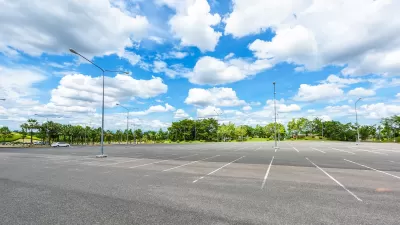The new parking policy creates a new, tiered framework for parking requirements and reduces the required number of parking spots near transit.

Fairfax County officials unanimously voted to reduce parking requirements under a policy known as ‘Parking Reimagined,’ reports Margaret Barthel in DCist.
“The new parking minimums depend on a variety of factors, including whether the project is residential, retail, or office, where it is located, and whether it’s close to transit.” The policy also requires bike and pedestrian infrastructure for large parking lots.
In addition to lowering the cost of housing construction, “County leaders hope the change — while modest — will ultimately mean more space for housing, parks, and other public amenities, instead of large, mostly-empty suburban parking lots that become heat islands in the summer and produce stormwater runoff when it rains.”
According to Barthel, “Most significantly, the new policy imposes a tiered structure for determining parking minimum requirements, cutting them back particularly in mixed-use areas near transit and in places designated by the county’s comprehensive plan for revitalization, such as Annandale and the Route 1 corridor.” The policy also simplifies rules around parking when a building changes hands.
Barthel notes that the policy does not change the amount of parking required for single-family homes or most townhomes, but could add new parking in areas around townhomes due to its requirement for visitor parking.
FULL STORY: Fairfax Supervisors Approve Plan To Reduce Parking Requirements

Maui's Vacation Rental Debate Turns Ugly
Verbal attacks, misinformation campaigns and fistfights plague a high-stakes debate to convert thousands of vacation rentals into long-term housing.

Planetizen Federal Action Tracker
A weekly monitor of how Trump’s orders and actions are impacting planners and planning in America.

San Francisco Suspends Traffic Calming Amidst Record Deaths
Citing “a challenging fiscal landscape,” the city will cease the program on the heels of 42 traffic deaths, including 24 pedestrians.

Defunct Pittsburgh Power Plant to Become Residential Tower
A decommissioned steam heat plant will be redeveloped into almost 100 affordable housing units.

Trump Prompts Restructuring of Transportation Research Board in “Unprecedented Overreach”
The TRB has eliminated more than half of its committees including those focused on climate, equity, and cities.

Amtrak Rolls Out New Orleans to Alabama “Mardi Gras” Train
The new service will operate morning and evening departures between Mobile and New Orleans.
Urban Design for Planners 1: Software Tools
This six-course series explores essential urban design concepts using open source software and equips planners with the tools they need to participate fully in the urban design process.
Planning for Universal Design
Learn the tools for implementing Universal Design in planning regulations.
Heyer Gruel & Associates PA
JM Goldson LLC
Custer County Colorado
City of Camden Redevelopment Agency
City of Astoria
Transportation Research & Education Center (TREC) at Portland State University
Jefferson Parish Government
Camden Redevelopment Agency
City of Claremont





























